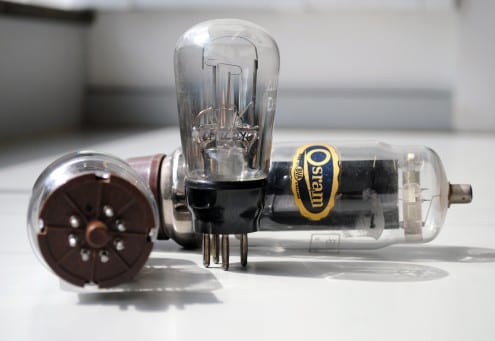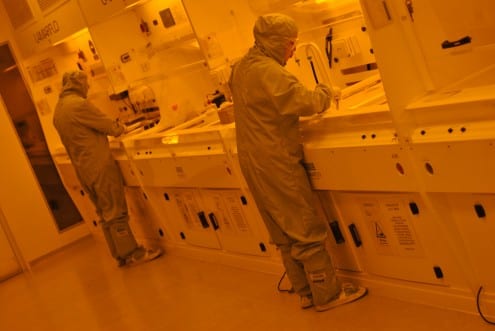Mars Express and the magnetism of the red planet
By Oli Usher, on 8 July 2014
Planet Earth is a vast magnet with a strong magnetic field surrounding it. As well as making compasses point north and guiding solar particles to the poles, creating the aurorae, the magnetic field protects our atmosphere. Shielded from the solar wind and from solar and galactic cosmic rays, Earth’s atmosphere is thick and life-sustaining and is not at any risk of being blown into space.
Mars – an Earth-like planet in many other respects – has lacked such a global magnetic field for about 3.8 billion years. Its atmosphere is thin – less than 1% of the atmospheric pressure we have on Earth – leaving a cold, hostile and barren surface.
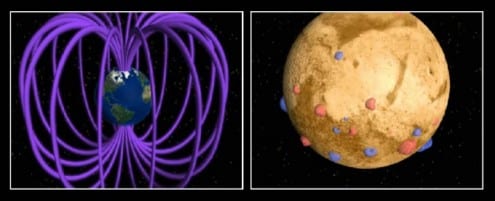
The magnetic fields of Earth (left) and Mars (right). Earth has a strong, planet-wide magnetic field that shields our atmosphere from the Solar wind. Mars has only small localised areas of magnetism called crustal fields, meaning its atmosphere interacts directly with the Solar wind. Credit: NASA/GSFC (public domain)
The lack of magnetic field makes Mars different from Earth in other respects too. In fact, in some ways Mars behaves much like a comet: since the Solar wind interacts directly with the atmosphere a comet-like tail of gas is constantly being blown off the planet (albeit not to the extent of a comet as it passes near the Sun).
UCL researchers have studied the behaviour of Mars and its interaction with the Solar wind for many years, including through participation in the European Space Agency’s Mars Express mission. Orbiting Mars since 2003, the mission has been a huge success (unlike the Beagle 2 lander it carried), and like many missions it carries UCL hardware contributions. This comes in the form of a sensor in the ASPERA-3 instrument, for which UCL carried out calibration and blackening (to prevent internal reflections degrading observations) prior to launch.
The ASPERA-3 instrument has helped UCL scientists study Martian magnetic anomalies called crustal fields. These are small, localised magnetic fields on the surface of Mars which interact with the Solar wind and material escaping the Martian atmosphere. It has also observed how the faint ‘tail’ of material streaming from Mars has photoelectrons caused by the Sun.
UCL is also involved in the exploration of the Martian surface – it leads the team building the main camera for the ExoMars Rover, Europe’s first Mars rover, which touches down in 2019.
The Alfvén conference, being held at UCL this week, is bringing together experts from around the world in the field of electrical, magnetic and plasma interactions in the Solar System. Today’s focus is Mars. Among the presentations will be new research on the data sent back by Mars Express, as well as the latest news from NASA’s MAVEN mission and India’s Mars Orbiter Mission, both on route to the red planet with expected arrival in September 2014.
This evening there will be a public lecture at UCL about the Rosetta mission, which is currently approaching Comet C-G. Matt Taylor, the scientific leader of Rosetta, will outline the probe’s amazing ten year journey, outline Rosetta’s scientific goals and explain why comets are such an important window into the distant past of our Solar System. The lecture is free and open to all, but please reserve your seat as spaces are limited.
Picture of the week: Release valve
By Oli Usher, on 7 July 2014
Semiconductors are the basis of almost all the electronics we are used to today. Transistors are tiny switches (often microscopic) which govern how electricity flows through a device, thanks to their variable electrical conductivity. Putting many transistors in sequence means the flow of electrons through the circuit can begin to follow logical rules and make calculations – the basis of all computing. Even small devices like smartphones can today contain over a billion transistors squeezed onto the tiny chips inside them.
But electronics existed before semiconductors. The transistor was invented in the late 1940s, and only became widely used in the mid 1950s, a decade after the invention of electronic computers.
Early electronic devices, including the first computers such as Colossus and ENIAC, relied instead on thermionic valves.
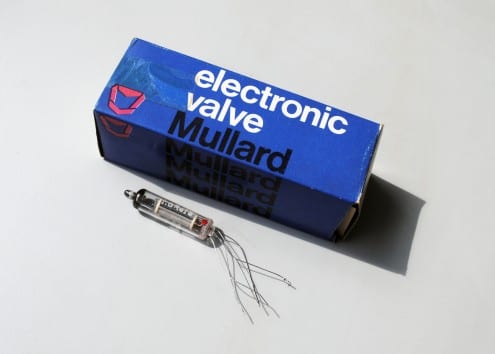
A small electronic valve manufactured by Mullard. (This is the same Mullard that endowed UCL’s Mullard Space Science Laboratory). Photo: O. Usher (UCL MAPS)
Dating back to the early 20th century, valves can carry out the same functions as semiconductors do today, acting as switches and diodes. But the principles they work on are totally different – instead of exploiting the quantum properties of semiconductors, valves use brute force: glowing hot filaments that flood the valve with electrons.
This means they are extremely energy-inefficient – the ENIAC computer, with just under 18,000 valves (compare this to over a billion transistors in an iPhone) drew 150 kilowatts of power. A typical oven uses around 2 kW, a modern laptop computer uses less than 0.1 kW.
This high power consumption also means that valves look a lot like another device with a glowing filament, appalling energy efficiency and vast production of waste heat: the filament light bulb. (Like old-style light bulbs, valves also regularly burn out and need to be replaced.)
Valves were widely used for electronic applications in university labs until their relatively sudden obsolescence in the 1950s left unused stocks in store rooms. They still occasionally turn up when cupboards are cleared out – including a large haul of several crates of mint-condition valves recently found in UCL’s Department of Chemistry, pictured here. These are of little use for research today, but they are of great historical interest, not least for restoring and repairing old electronic devices.
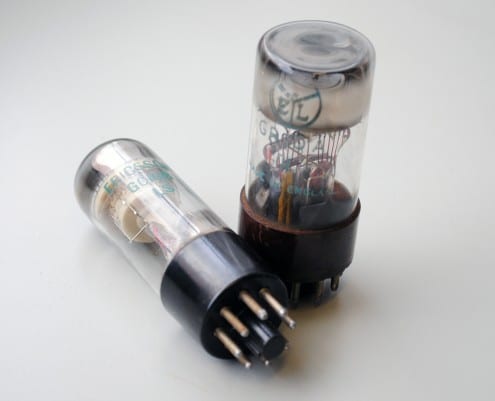
Dekatrons (counting tubes) were widely used in early computers including the Harwell Dekatron Computer, which is now at the National Museum of Computing.
For this reason, the valves have been donated to the National Museum of Computing at Bletchley Park.
Links
High resolution images
Rosetta: The best ever opportunity to study a comet
By Oli Usher, on 7 July 2014
The European Space Agency’s Rosetta mission, coming to its climax only now, a decade after launch, will have a number of scientific firsts: the first probe to follow a comet around the Sun while it orbits, the first to orbit a cometary nucleus, and the first to deploy a lander on the comet’s surface.
UCL has made a major contribution to the scientific programme the spacecraft, thanks to its long-standing expertise in plasma physics. Much of this expertise was gained in a previous space mission.

Artist’s concept of the Giotto spacecraft approaching Comet Halley. Credit: Andrzej Mirecki (CC-BY-SA 3.0)
In 1986, the Giotto probe flew by Comet Halley, giving the first ever close-up view of a comet’s nucleus. UCL built the probe’s Fast Ion Sensor and led the Johnstone Plasma Analyser team. Thanks to this detector, scientists were able to study the interaction between the comet and the solar wind as the comet ploughed through it, including the enormous bow-shock in front of the comet that extended for around a million kilometres, and the processes by which cometary ions are ‘picked up’ by the solar wind.
Rosetta should give us a lot more than this. Two decades of technological progress mean sharper photos and more sensitive instruments. But the major improvement is in how long the probe will be able to study the comet for, as well as its close-up study of the comet’s ionosphere. Giotto made only a relatively short flyby of Halley, in large part because the comet’s orbit is highly inclined and moves in the opposite direction to Earth’s, and it only passes through the plane of the Solar System on two brief occasions every 76 years. Comet Churyumov-Gerasimenko, Rosetta’s target, is in an orbit that is easier to rendezvous with, which means – with some admittedly difficult and time-consuming orbital mechanics – Rosetta can be brought into orbit around it.
This, in turn, means the changes in the comet, including the growth of its coma, and plasma (gas) and dust tails, can be charted in detail as it proceeds around the Sun.
UCL scientists at the Mullard Space Science Laboratory are particularly closely involved in the Rosetta Plasma Collaboration, a scientific group which will study the electrical properties of the comet as it interacts with the Solar wind. This is a direct continuation of the work done with Giotto nearly three decades ago.
The wait won’t be long now – Rosetta is less than 30,000km from its goal (less than the distance between Earth and geostationary communications satellites), and will begin manoeuvring into orbit in early August. Early data will come sooner, with the first detection of the comet’s plasma expected perhaps as early as this week.
Rosetta is one of a number of missions being discussed at the Alfvén Conference this week at UCL. Named after Hannes Alfvén, a Swedish plasma physicist and Nobel laureate, the conference is bringing together experts from around the world in the field of Solar System plasma interactions, such as those Rosetta will study.
As part of the conference, Matt Taylor, the scientific leader of the Rosetta project will be giving a public lecture tomorrow (Tuesday 8 July) at 6pm. He will outline the probe’s amazing ten year journey, outline Rosetta’s scientific goals and explain why comets are such an important window into the distant past of our Solar System. The lecture is free and open to all, but please reserve your seat as spaces are limited.
Miracle on Gordon Street
By Oli Usher, on 3 July 2014
“I joined UCL in 1998. I remember saying in the job interview, ‘in two years, I’ll achieve electrochemistry in the gas phase’. Fifteen years later I think I might have achieved it,” says Daren Caruana, a UCL Chemist.
“On the bright side, though, I still have my job.”
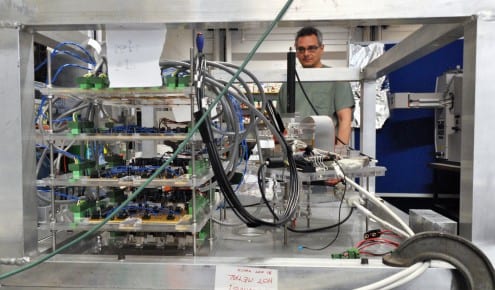
Daren Caruana, seen through his prototype electrochemical device for tuberculosis testing. Photo: O. Usher (UCL MAPS)
Electrochemistry is the study and manipulation of matter based on the behaviour of its electrons. It covers a huge range of phenomena, from electroplating cutlery with silver to glucose testing of blood samples for people with diabetes. Electrochemistry needs to be done in an electrically conductive liquid, which brings with it complications – it means the sample isn’t clean, and the solvent can often be toxic or corrosive.
There is, however, no reason why the same type of chemistry cannot be done within a gas, which would eliminate many of these problems.
But the gas has to be electrically conducting, which rules out air.
Fortunately – as anyone who remembers high school chemistry should remember – flames conduct electricity.
Unfortunately for Caruana, turning theory into practice when it involves flammable gases is not entirely straightforward. Hence his plans falling a little behind schedule.
One early experiment using hydrogen gas exploded, showering the entire room with shards of glass – except for his research assistant who was standing right next to the equipment. (The assistant, a devout Catholic, wrote to the Pope to report this possible miracle. Caruana served a term as deputy Departmental Safety Officer as penance.)
***
After years of finessing the technique of electrochemistry in flames, Caruana’s current project is to use it to test people with tuberculosis.
When infected with the disease, some people are highly contagious as they breathe out a constant stream of bacteria, while others are not. Currently the only way to test this is to make them breathe on agar, and wait and see if any bacteria reproduce. But his plan is to build a relatively cheap electrochemical device that will give a near-instant diagnosis.
In his lab, Caruana has a prototype (built entirely in-house by Dr Matt Li), a Heath Robinson-esque contraption of Perspex, screws, circuit boards and a great deal of Blu-Tack. But in time this should be possible to shrink down to the size of a desktop computer.

Like a lot of scientific experiments, Caruana’s device is held together with a lot of Blu-Tack. Photo: O. Usher (UCL MAPS)
In the device, the patient’s breath is blown in a narrow stream through the flame, and one-by-one, the bacteria are incinerated. Different types of bacteria have different properties which can be clearly detected by the electrical properties they display as they pass through the flame, either because they have a different chemical makeup or different physical properties. For instance, Mycobacterium tuberculosis, the pathogen that causes TB, has a tough outer shell. This means that it visibly pops in a tiny explosion when it passes through the flame.

Up close and personal: when in operation, the device emits a flame through the centre of the brass circle. The stream of bacteria is blown through it. Photo: O. Usher (UCL MAPS)
For safety reasons the current tests with the equipment are concentrating on non-infectious bacteria with similar properties to TB. But, in partnership with Prof Ibrahim Abubakar, Prof Timothy McHugh and Dr Marc Lipman from the Royal Free Hospital and UCL Business he hopes to continue the development, including tests on live TB bacteria. The aim is to have a commercial device ready to roll out to health centres around the country in the next three to five years.
Cleaning up in the cleanroom
By Oli Usher, on 30 June 2014
Many scientific processes need spotlessly clean labs. In the life sciences, samples can be contaminated by bacteria or moulds; in chemistry, samples may become impure. In the London Centre for Nanotechnology, where scientists and engineers develop and study microscopic devices, dust is one of the major enemies – and it must be excluded before the researchers can do their work.
The LCN’s cleanroom is a large, sealed facility in which much of this type of research takes place. Users of the facility have to wear special protective suits to prevent dirt and dust from their clothes from contaminating the lab, while any equipment brought into the room needs to be carefully cleaned.
This spotlessly clean environment means that highly precise work can be carried out. One example is photolithography, where the tiny electronic circuits on chips are etched using ultraviolet light. (The room is lit in orange, which is far away from ultraviolet in the electromagnetic spectrum, to avoid damaging this process.) The clean environment helps ensure that the correct patterns are imprinted on the silicon surfaces.
Links
High resolution images
What’s the chance?
By Oli Usher, on 23 June 2014
What are the chances of a fair dice landing on each of its faces? One in six of course. But unfair dice are another matter entirely: nobody has ever come up with a complete mathematical explanation of their probabilities.
Two UCL PhD students from UCL Department of Physics & Astronomy, George Pender and Martin Uhrin have taken a step closer to this, coming up with a theory that can explain the behaviour of biased two-dimensional (four sided) dice, and similar objects such as dreidels (a type of spinning top).
This picture shows a fair spinning dreidel (top left), a biased one (top right) and a fair die.
Links
High resolution images
Successful launch for UCL space technologies
By Oli Usher, on 20 June 2014
In space, space is at a premium.
Launching a satellite is hugely expensive. Every kilogram it weighs and every cubic centimetre it takes up costs money. Spacecraft engineers have therefore had to become experts at miniaturisation – and nowhere is this more obvious than with the CubeSat concept.
CubeSats are a class of tiny spacecraft. They are based on cubes just 10cm along each side, and up to three can be joined together into a single satellite. Thanks to their diminutive size, they can easily piggyback on other launches that have spare capacity, or alternatively many CubeSats can be launched in one go.
The most ambitious CubeSat project to date is a European project called QB50, which plans to send 50 CubeSats into orbit in one launch in early 2016. This will be the largest number of satellites ever put into orbit on board a single rocket.
Each of the satellites will be built by a separate institution from around the world (including one – UCLSat – by UCL’s Mullard Space Science Laboratory). Up to 40 of them will sport sensors that can probe the properties of the upper atmosphere. The consortium providing the sensors is led by UCL MSSL, which will build 14 spectrometers that will analyse the relative proportions of different types of particles in the thermosphere.
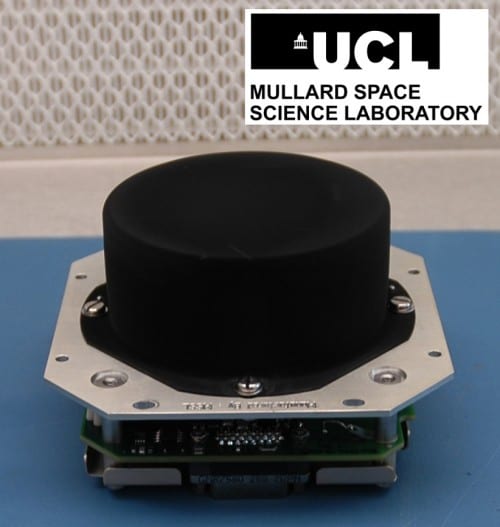
The Ion & Neutral Mass Spectrometer, designed and built at UCL, prior to being attached to the CubeSat. The device is less than 10cm across.
As the orbits of the 50 satellites gradually decay, they will spread apart, giving a unique opportunity to measure the upper atmosphere in multiple locations at the same time, using the same type of instrumentation.
QB50 is an ambitious programme, and so a precursor mission using just two satellites is now underway. Launched on 19 June from the Russian space centre at Yasny, the precursor satellites have a UCL-built Ion and Neutral Mass Spectrometer (INMS, which measures atomic and molecular oxygen, along with molecular nitrogen) and a Flux (Phi) Probe Experiment (FIPEX, which detects atomic and molecular oxygen) procured from the Technical University of Dresden.

The two complete satellites for the QB50 precursor flight. THe satellite on the right has an Ion Neutral Mass Spectrometer, built by UCL, attached to its top surface. The satellite on the left has a Flux (Phi) Probe Experiment, designed by the Technical University of Dresden
As well as being very small, the instrumentation for the QB50 test mission had to be developed very fast, over a period of just a few months. Mission approval came in October 2013, and the completed satellites had to be delivered to the launch site in May 2014.
A further test of UCL’s miniaturisation technology will come with TechDemoSat, a UK satellite that launches on 8 July, and NASA’s Sunjammer mission in January next year.

Dhiren Kataria (right), the MSSL detector physicist behind the QB50 INMS instrument. Behind him, the CHaPS payload for the forthcoming TechDemoSat mission (based on the same technologies as QB50 INMS) being prepared for testing in a calibration chamber
Message to Mercury
By Oli Usher, on 16 June 2014
Of all the planets of the inner Solar System, Mercury is the least-visited. No mission has ever landed on its surface, only two missions have studied it from space, and only one of those has reached orbit.
Travelling to Mercury is difficult as the proximity to the Sun makes for unstable orbits and fast orbital speeds.
The first spacecraft to visit Mercury was Mariner 10, pictured here in an artist’s impression from UCL’s planetary science archives. UCL is the only UK institution to host a NASA Regional Planetary Image Facility.
Mariner 10 made three fly-bys of Mercury in 1974 and 1975, mapping a little under half of the planet’s surface.
The complex path to Mercury, involving multiple fly-bys, was designed by scientist Bepi Colombo, whose name is honoured by a forthcoming mission planned by the European Space Agency and the Japan Aerospace Exploration Agency. The BepiColombo mission, expected to launch in 2016, will feature two orbiters, and will fly past the planet several times before reaching orbit in 2024.
UCL’s Prof Alan Smith is chair of the UK Space Agency’s BepiColombo management board.
Image credit: NASA/RPIF/UCL Earth Sciences
Links
- Snapshots from Space History (UCL RPIF public outreach website)
- UCL Regional Planetary Image Facility
- UCL Earth Sciences
- UCL Mullard Space Science Laboratory
High resolution image
Picture of the week: What’s the charge?
By Oli Usher, on 9 June 2014

Tool used to demonstrate electric charges. Credit: O. Usher (UCL MAPS). Acknowledgement: Jim Grozier
When metal objects are given an electric charge, the charge is not evenly spread through it. It collects on the surface, and in particular on parts of the surface which are curved.
This object from the collections of the Department of Physics & Astronomy is a historic teaching device that would have been used to demonstrate this phenomenon in times past.
Sitting atop an insulating stand, the device would be charged up and retain the charge long enough for a lecturer to carry out a demonstration. Using a small square of metal on an insulating handle, attached to an electroscope, the demonstrator would be able to show that the charge was concentrated on the sharply curved area on the right hand side in this photo.
Photo credit: O. Usher (UCL MAPS). Acknowledgement: Jim Grozier
Links
High resolution images
Picture of the week archive
By Oli Usher, on 2 June 2014
From now on UCL science pictures of the week will be published on this blog.
For older entries, see the picture of the week section of the Faculty of Mathematical & Physical Sciences website.
 Close
Close



